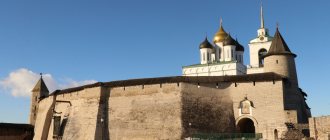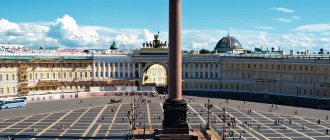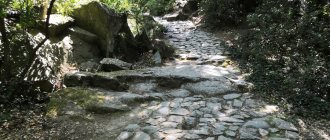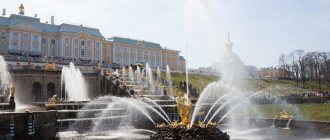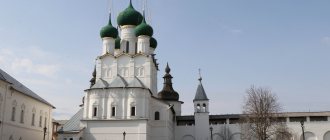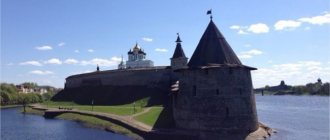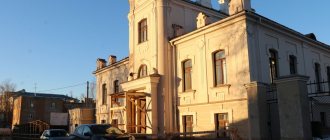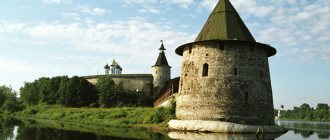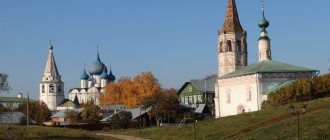> Countries Russia
Pskov is one of the oldest cities in Russia, where unique buildings have been preserved, giving an idea of what medieval Rus' looked like. The rich history has left many architectural and cultural attractions both in the center and in the surrounding area, and many museums. At the same time, the city is actively developing, and new interesting places are appearing. You can expand your trip by visiting ancient monasteries and medieval fortresses in the region or relaxing on the shores of Lake Peipsi. A list of the main points in the center that are easy to get around on foot, as well as travel options nearby, is in this post.
- Sights of Pskov
- Unusual points
- Excursions
- In area
- Museums
- How to get there
- Where to stay
- On the map
In the center
Pskovsky Krom
The Pskov Kremlin (Krom) is the place where Pskov was born in the 10th-11th centuries. At that time, the territory of the Kremlin was relatively small, but gradually new defensive walls appeared around it, and its area increased, dividing the city into Zastenye (behind the first stone walls) and Zapskovye (behind later walls). Impressive fortifications reflected a real need - being located in the very west, on the border with other states, they were constantly under threat of attack and successfully repelled attacks from the Golden Horde, the Livonian Order, Sweden and the State of Lithuania.
Nowadays, inside Krom, the Trinity Cathedral, Dovmontov Castle, the Prikaznye Chambers, as well as defensive walls and towers of the 14th-17th centuries have been preserved. Even today, one is struck by the inaccessibility of the walls, together with the general harmony of the architectural ensemble, rising above the confluence of the Velikaya and Pskova rivers.
st. Kremlin, 2
Opening hours: 06:00 – 22:00
Free admission.
Dovmontov Grad
It’s hard to imagine, but the surviving foundations of 13th-century structures near the Kremlin were discovered only in the 1950s. They allowed us to better understand what architecture was like at that time. It is clearly noticeable that all the buildings stood almost close to each other - as many as ten temples fit into this territory. Next to the foundations is an information board with a picture and description of what they most likely looked like.
Trinity Cathedral
The current 17th-century cathedral is the fourth building on the site of previously burned cathedrals, the first of which was erected by order of Princess Olga. The cathedral, unusually tall for Russian churches, consists of seven tiers, thanks to which it can be seen from different parts of the city. The architecture combines typical Pskov features and features of the Moscow style. Trinity Cathedral is one of the main shrines of the region, where important icons and historical chronicles are kept.
During the time of the Principality of Pskov, a meeting gathered on the square in front of the cathedral, where all important political and social decisions were made. The temple was active until the advent of Soviet power. For some time, an anti-religious museum operated here. Now it belongs to the church again.
Order chambers
The chambers performed an administrative function. Now there is a local history museum. The hipped roof has not been preserved, but a model of the original appearance of the building is inside the museum.
Walls of the Okolny town
The expansion of the Kremlin and fortifications continued due to the walls built in the 16th century around a fairly large area of the current historical center. Surprisingly, most of the walls, three kilometers long, have been preserved and run along modern streets: Kalinin, Sovetskaya and Karl Marx. The complex was also complemented by 50-meter towers, of which only three have survived: Pokrovskaya, Petrovskaya and Mikhailovskaya.
Mirozhsky Monastery
A 12th-century monastery with the only pre-Mongol frescoes preserved in Russia. Soon after its creation, the monastery turned into the cultural center of the city, occupying an increasingly larger area, including the river bank. After the secularization of the lands and the further seizure of the Livonian Order, the territory of the monastery was significantly reduced - approximately to its current size. The oldest and only building that has survived from the founding of the monastery is the Cathedral of the Transfiguration. The remaining buildings date back to the 16th-19th centuries.
Mirozhskaya embankment, 2
Opening hours: Tue-Sun 11:00 – 18:00
Entrance to the monastery territory is free; to church: 200-350 R
Pogankin chambers
One of the oldest residential buildings of the 17th century, which has survived to this day, gives an idea of what the residential buildings of those times looked like. Three multi-storey buildings are built of limestone and whitewashed. There is a legend that the merchant Pogankin, who owned the chambers, walled up his wife in one of the walls. Now the chambers are occupied by the Art Museum-Reserve with an exhibition of paintings.
st. Nekrasova, 7
Opening hours: Tue-Sun 11:00 – 18:00
Entrance: 250 RUR, there are benefits
Cathedral of John the Baptist
One of the oldest Pskov cathedrals is located in the Zavelichye district. The unusual name of the area is due to the fact that it is located on the opposite bank of the Velikaya River from the center. Due to the cultural layer, which has risen by more than a meter, it seems that the temple is gradually going underground. Its architecture displays the features of the Pskov style: simplicity, lack of decoration on the facade and elegance of lines with complete harmony of architectural forms. During Soviet times, the church cemetery was destroyed and the bells were melted down. After a long period of use of the building as a warehouse, a large-scale reconstruction was carried out. Now the appearance of the cathedral is close to the original.
st. Maxim Gorky, 1
Opening hours: 09:00 – 19:00
Free admission
Golden embankment
Golden Embankment is a newly created pedestrian area opposite the Kremlin. There are houses stylized as 19th-century buildings and cafes, but the best thing here is the view of the architectural ensemble of the Kremlin, rising above the confluence of rivers.
Church of Varlaam Khutynsky on Zvanitsa
Like the temple of the same name in Vologda, it received its name in honor of Varlaam Khutynsky, who founded the Spaso-Preobrazhensky Monastery of Novgorod. It was opened in the 15th century to get rid of the plague. The architecture has changed significantly over time, chapels have been added and the roof has been rebuilt.
st. Leona Pozemsky, 53
Free admission.
Embankment of the Velikaya River
Another excellent walking area, completely reconstructed a few years ago. From here you can see the Mirozhsky Monastery and the Zavelichye area.
Church of St. Basil the Great on Gorka
An amazingly beautiful and harmonious temple, rising above a once marshy area. It reflects all the main styles of Pskov architecture of the 15th century: geometric friezes, modest decoration, three-apse structure, whitewashed limestone facade. Unfortunately, the church was heavily rebuilt and the interior was lost, but thanks to its unique architecture, it was included in the UNESCO World Heritage List.
Oktyabrsky p., 5
Free admission
Snetogorsk Monastery
Not far from the center there is a 13th-century monastery - one of the most important shrines in the region. It was here that the princes were tonsured, and unique frescoes were preserved inside, which were whitewashed for a long time and discovered only at the beginning of the 20th century. Surprisingly, the architecture of the cathedral was copied from the main cathedral of the Mirozhsky Monastery, which was a common practice at that time.
Wiki/Commons
st. Snyatnaya Gora, 1
Opening hours: 09:00 – 21:00
Free admission
Interesting places
Observation deck with Olginskaya Chapel
Not only does it offer the best view of the Kremlin and Trinity Cathedral, but this place is also associated with the legend of the founding of Pskov. According to her, it was here that Princess Olga stood when she saw three connecting beams on the opposite bank. She took this as a sign that this was a good place for the future of the city. On the opposite bank there is the famous inscription “Russia begins here” - one of the symbols of the city. It refers both to the ancient history of Pskov and to the fact that it is located in the very west of the country.
Zapskovye
Once upon a time, the Zapskovye region, adjacent to the center, was inhabited by Germans and other foreigners. Unfortunately, not a single building has survived from those times, and all foreigners were resettled with the annexation of Zapskovye to Pskov. This is the most cozy area with an inexplicable old Russian atmosphere. Ancient churches can be found every now and then on the quiet streets, and residential buildings consist mainly of wooden houses and low-rise residential areas.
It is also worth looking at the Meyer Rope Factory (22 Leona Pozemsky St.), a pre-revolutionary enterprise in the Art Nouveau style. You can get to Zapskovye by walking along the Golden Embankment and turning right.
Rattling Tower
A 14th-century tower on Gremyachaya Mountain, rising above the Pskovaya River. The impressive tower in a quiet place in Zapskovye has always been shrouded in many legends. For example, that the enchanted prince’s daughter is still sleeping inside, and can only be awakened by someone who reads the psalms at her sarcophagus. However, according to legend, as soon as the young men begin to read, evil spirits appear and throw them out of the tower.
Rusinov Chambers
Another example of residential stone buildings from the 17th century. The complex of buildings, including residential buildings, utility and storage facilities, belonged to the Rusinov family, one of the richest local families of that time. Once Peter I, who knew his family, even stayed in the chambers here. Unfortunately, this unique civil building had not been used for several decades and was in a dilapidated state. Now the building is in great ruins, but complete restoration is planned in the coming years.
The Rusinov courtyard is located on one of the busiest streets - Karl Marx Street. A large number of cafes and restaurants are concentrated on it; the city market is located near the embankment, as well as the pedestrian Pushkin Street.
Neighborhood
Pechory
Pechory is a city 50 kilometers from Pskov, where people come primarily for the Pskov-Pechora Monastery. This is one of the oldest monasteries in Russia, founded in the 15th century and since then has never interrupted its work. Since the history of the monastery is extremely rich, it is better to go here on a tour with professional guides. Tours often cover both Pechory and Izborsk - it’s convenient to see both of these places in 1 day.
Izborsk
Izborsk is a small town 30 kilometers in the direction of Pechory. It is considered one of the most ancient cities in Russia, although now it has the status of a village. The main reason to come here is the Izborsk fortress of the 14th century, preserved in very good condition for its advanced age. It’s convenient to get here by bus, car, or with a tour:
Pushkin Mountains
A little further there is a famous and beautiful place - the Pushkin Mountains, located 120 kilometers away. It’s worth devoting at least a whole day to a trip to Pushkin’s places, as they are full of historical sights, and you can learn everything about these places on an individual excursion:
Lake Peipsi
The main lake of the Pskov region, which it shares with Estonia, where it is called Peipsi. It was here that the Battle on the Ice of Alexander Nevsky and the Livonian Order once took place. Now it is a very quiet and peaceful place, and the shore of the lake resembles the shore of the Baltic Sea: sandy beaches surrounded by dense forests. It’s worth a trip here to relax, admire the beautiful scenery, or stay at one of the many coastal resorts.
Wiki/Commons
Smolinskoe Lake
Another picturesque lake in the Palkinsky district. The name comes from the traditional activity of local residents - collecting resin. During the Great Patriotic War, the Germans set up a concentration camp on its banks, traces of which have not survived. Now this is a good direction to go to relax in nature. Smolinskoe Lake is a favorite place for swans, so they are found here quite often.
Museum-estate N.A. Rimsky-Korsakov in Lyubensk
On the way from St. Petersburg, it is convenient to stop by the Rimsky-Korsakov Museum, located not far from Luga in the Plyussky district in the village of Lyubensk. This is an atmospheric place with a restored manor where the composer lived in the last years of his life. The exhibition will tell about these years through personal belongings, household items and a recreated interior.
Geography and climate
Pskov is located in northwestern Russia near the border with Estonia and Latvia. The city lies on the lowland of the same name on the Velikaya River, where the Pskova River flows into it. Pskov Lake is 16 km away.
Pskov has a transitional climate from maritime to temperate continental. Summer here is relatively warm and quite rainy. Winter is cool, with usually persistent light frosts, which can be replaced by thaws.
Ancient Krom - the oldest part of Pskov
Museums
Pskov Museum-Reserve
The museum-reserve occupies several historical buildings: the Kremlin, the Prikazny and Pogankin chambers and a branch on Nekrasova Street. Each of them is a branch with its own exposition on various topics. Usually one of the branches is located in the Pogankin Chambers, but now it is closed for restoration.
Branch on Nekrasova
The exhibition is dedicated to ancient Russian culture and the history of the Pskov region during the Second World War.
st. Nekrasova, 7
Opening hours: Tue-Sun 11:00 – 18:00
Entrance: 300 rub.
Order chamber
The museum will tell you about the history of the chambers and what administrative function they played in Rus'. Temporary exhibitions also change here regularly.
Kremlin
Opening hours: Tue-Sun 11:00 – 18:00
Entrance: 150 rub.
Mason's House
The museum occupies an Art Nouveau mansion that once belonged to the Scotsman Mason. The unusual surname turned into the well-known word “Mason”, which is where the name of the house came from. After the revolution, the building was occupied by communal apartments for a long time, until it was occupied by a museum-reserve, placing a storage facility here. There are also exhibitions open to visitors dedicated to the life of local residents of the century before last and heraldry.
Komsomolsky lane, 6
Opening hours: Tue-Sun 11:00 – 17:00
Entrance: 150 rub.
Kaverin Museum
The Kaverin Museum “Two Captains” is dedicated to the famous novel, but will also tell about the life of the writer. Most of the exhibition is devoted to the history of the creation of the novel; items from the musical “Nord-Ost” and the first editions of the novel are collected. The other part consists of the writer’s personal belongings, from which you learn more about his biography. The museum is now temporarily closed for restoration.
Profsoyuznaya st., 2
Free admission.
Railway Museum
Free Russian Railways Museum opposite the main station. It will be of interest to fans of railway transport and railways in Russia.
st. Jan Fabricius, 29
Opening hours: Tue-Sat 11:00-17:00
Free admission.
Route around Pskov for 2 days on the map
- Tours to Belek (Turkey) for 7 nights, 4-5* hotels, all inclusive from RUB 51,757 for TWO – June
- Hill Palatine in Rome
- Alanya hotels for families with children
- Ayia Napa 4 star hotels first line
- Tours to Greece for 7 nights, 3 and 4* hotels all inclusive from 48,913 rubles for TWO – June
- The Berlin Wall is an ominous monument to the Cold War
- 15 best health resorts in Turkey
- St. Petersburg hotels for newlyweds
- Stanzas of Raphael in the Vatican Museum
- In Bali on your own
- Tours to Turkey for 12 nights, 5* hotels all inclusive, 2 adults + 2 children from RUB 145,561 for FOUR – June
- Alanya or Antalya
Where to stay
Pskov has quite a large selection of housing that will suit any budget. For budget travelers, hostels are a great option for one night. The best hostels: Hostel - Pskov, Happy Slud (I personally stayed there, a good option right next to the station), Petrovsky.
The best value for money is found in apartments and hotels in the center: Apartment on ulitsa Gogolya 7 B, Greenfeel Hotel, On Sovetskaya.
The most convenient way to find the best accommodation options is on Hotellook
How to get there
Pskov has a small regional airport with several weekly flights to Moscow and St. Petersburg. The best way to get to Pskov is to fly to St. Petersburg and then take a high-speed train or bus. Trains from Moscow are very slow. It's better to choose a bus. Pskov has regular bus service with Moscow, St. Petersburg, Veliky Novgorod, Vitebsk, Tallinn, Riga and Tartu.
Walls of the Pskov Kremlin
